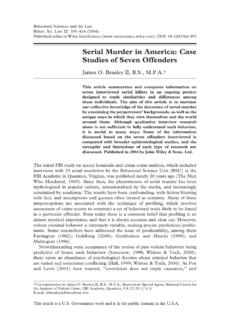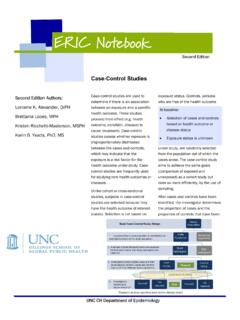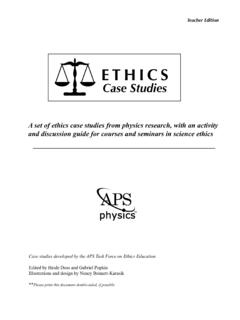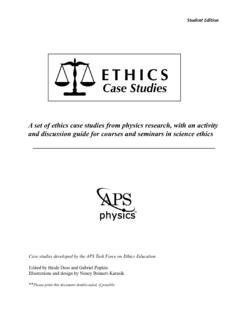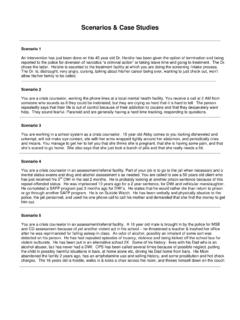Transcription of Corporate Goverance Case Studies
1 Corporate Governance case StudiesEdited by Mak Yuen TeenForewardStrong Corporate governance and transparency are critical for business success. For investors, good governance is a good indicator of well-managed, resilient businesses. For companies, a measure of success is the ability to internalise the values, spirit and purpose behind governance the governance standards in Singapore have brought us to where we are today, we have some way to go if we want to be seen as leaders in this area. Regulators, directors, management, investors, industry groups and professional bodies all have a part to play. The collective efforts of all these stakeholders will be needed to sustain the drive to improve governance and support the government s vision of positioning Singapore as a global financial inaugural collection of teaching case Studies aims to raise awareness and promote thoughtful discussions on key Corporate governance issues in companies across several markets, particularly in Asia.
2 The authors have endeavoured to present the facts and issues based on publicly-available information covering matters such as the board, board committees, ownership structure, Corporate governance rules and regulations, auditors and remuneration. Following each case study are discussion questions which we hope will facilitate a robust exchange of views to help lead efforts to advance Corporate governance standards and best practices in would like to thank Associate Professor Mak Yuen Teen for supervising and editing the case Studies produced by students of the NUS Business School. We trust you will find the cases a good starting point to study governance issues that may be relevant to your professional Ong FCPA (Aust.)President SingaporeCPA AustraliaApril 2012 PrefaceIn early 2010, I started coordinating and teaching the Corporate Governance and Ethics course at the NUS Business School.
3 This is a compulsory third-level course for all students in the BBA (Accountancy) programme at the school. I thought that a great way for the students to learn is through case Studies . Unfortunately, there are very few case Studies in Corporate governance, and even fewer which are Singapore- or Asian-focused. The lack of good Asian case Studies in Corporate governance has also been raised by practising directors and others involved in training programmes for directors. I therefore decided to incorporate a case writing component into the course by getting the students to form groups and write comprehensive cases as part of their course assessment. This publication contains the abridged versions of 18 of these cases. The cases are diverse in many ways. Eight of these cases involve companies listed in Singapore, including some foreign companies.
4 Five involve other Asian companies in Hong Kong, India and Malaysia, while the remaining five involve non-Asian companies. However, this is a simplification as the cases often cross national boundaries. For example, there is a bribery case which involves a Singapore company and Apple in the US. The case on the failed merger between SGX and ASX is really an international case . The reason why I also included non-Asian cases is because, while there are differences in rules, regulations and norms and unique Corporate governance issues in Asia, the international cases allow the learning of differences around the world and also a comparison with Singapore and Asia. In any case , with globalisation, executives, accountants and regulators will increasingly need to understand Corporate governance from a more international cases are also diverse in terms of issues raised.
5 They illustrate that Corporate governance is much more than about just rules and regulations or about legal duties and liabilities of directors. At the risk of simplification, four of the cases deal with mergers and acquisitions, two with privatisation, three with bribery, ethics and Corporate responsibility, three with boardroom issues or conflicts, and five deal with Corporate governance crises or scandals. However, each case inevitably touches on other issues, including regulatory frameworks; roles of directors, auditors, and regulators; executive and director compensation; shareholder activism; and so should be noted that the cases are written for the purpose of generating discussion and are intended to be used for analysis. Therefore, they do not include analysis or interpretation of the situations.
6 Teaching notes which include some analysis and interpretation have been prepared. These teaching notes are only available to the instructor or facilitator using the cases for teaching or training. I believe the abridged versions will be useful for qualifying and continuing education programmes for directors, CFOs, accountants, regulators and other professionals. Although the copyright for the cases resides with CPA Australia and me, it is not our intention to restrict the use of these cases or to profit from the copyright. Our general principle is that programmes which are commercial in nature should pay to use these cases so that funds can be generated to further this initiative or benefit charity. We would be open to free use of these cases in programmes which are non-commercial in nature, subject to permission being obtained from CPA Australia or me.
7 Any surpluses generated from the publication of the cases will either be donated to charity or reinvested into this would like to thank CPA Australia for its generous support of this project. I am also grateful to the students who helped in editing these cases and, of course, to the students who helped in preparing the initial cases. They are acknowledged in the first footnote of each case . I would also like to specifically mention the capable support provided by the project manager, Kellynn Khor, who is doing a BBA degree in finance at the NUS Business School and a Master of Public Policy degree at the Lee Kuan Yew School of Public hope you will find this collection to be Yuen Teen, PhD, FCPA (Aust.)Associate Professor of AccountingNUS Business SchoolNational University of SingaporeApril 2012 ContentSingapore : The Fight towards Privatisation 6In Deep Water: Boardroom Tussle at Asia Water Technology 17 Japan Land: The Setting Sun 27 JLJ Holdings Limited: Poisoned by Its Rotten Apple 37 Sino Environment: An S-Chip Scandal 48 The Battle for Parkway 56 The Failed SGX-ASX Merger 68 The Sour Apple: The Fall and Fall of New Lakeside 80 Asia CasesCITIC Pacific: Foreign Exchange Scandal 90 Dialling for Votes: The PCCW Privatisation Scandal 98 GOME: A Boardroom Fight from Prison 106 RINO: Reversing into Trouble 122 The Satyam Fiasco 131 The Sime Darby Financial Fiasco 142 World CasesCadbury and Kraft: A Bittersweet Moment 152 Drilling into Disaster: BP in the Gulf of Mexico 162HP: The Mark Hurd Saga 175 MicroHoo!
8 : The Attempted Takeover of Yahoo! By Microsoft : The Fight towards Privatisation 6 This is the abridged version of a case prepared by Chew Yi Ling, Goh Theng Hoon and Thomas Sim Joo Huat under the supervision of Professor Mak Yuen Teen. The case was developed from published sources solely for class discussion and is not intended to serve as illustrations of effective or ineffective management. Consequently, the interpretations and perspectives in this case are not necessarily those of the organisations named in the case , or any of their directors or employees. This abridged version was prepared by Koh Kian Sin under the supervision of Professor Mak Yuen Teen. Copyright 2012 Mak Yuen Teen and CPA Tang: The Fight towards PrivatisationCase OverviewIn 2009, Tang Wee Sung, the majority shareholder of Tang Limited, along with his brother, Tang Wee Kit, finally succeeded in privatising the company after two failed attempts in 2003 and 2006.
9 The major controversy surrounding the privatisation was the valuation of Tangs Plaza, a commercial property located in the prime shopping district of Orchard Road. Minority shareholders cited its undervaluation as the primary reason for rejecting the cash offer by the Tang brothers. The minority shareholders felt that the redevelopment potential of the property should have been taken into consideration. In 2011, the Tang brothers failed in their attempt to cancel out all remaining shares held by minority shareholders through a capital reduction exercise. The objective of this case is to allow a discussion of issues such as the divergence of interests between controlling and minority shareholders, the manifestation of this divergence in a privatisation situation, the different methods of privatisation which can be used and the extent to which they protect the interests of minority shareholders, and the role of the board, audit committee, independent financial adviser, regulator and shareholders in a : The Fight towards Privatisation7 About Tang Limited is a Singapore-based company founded by Tang Choon Keng in 1932.
10 The company is in the business of departmental store retailing and general merchandising. Since 1958, the company has been operating at its flagship building, Tangs Plaza, along Orchard Road1. Tang is a company characterised by the presence of a major controlling shareholder. For example, in June 2003, then CEO-Chairman Tang Wee Sung, the second son of the founder, owned per cent of the company s 1975, Tang was listed on the then Singapore Stock Exchange, which later became the Singapore Exchange (SGX)3. However, since 2003, the Tang family had been trying to delist and privatise the company4. After two failed attempts, the Tang family finally succeeded and the company was delisted on 24 August 20095. In 2011, Tang made an offer to about 500 minority shareholders who had held on to the shares of the delisted company.


